Namur Gate
The Namur Gate (French: Porte de Namur, pronounced [pɔʁt də namyʁ]; Dutch: Naamsepoort) was one of the medieval city gates of the second walls of Brussels, Belgium. In the 21st century, Namur Gate denotes the Ixelles neighbourhood where the gate formerly stood, rather than the former gate itself. This area is served by Porte de Namur/Naamsepoort metro station on lines 2 and 6 of the Brussels Metro.
| Namur Gate | |
|---|---|
Porte de Namur/Naamsepoort | |
| Part of Second City Walls of Brussels | |
| Brussels, Belgium | |
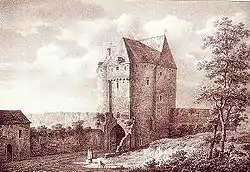 The Namur Gate at the end of the 18th century | |
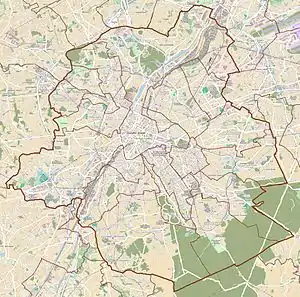 Namur Gate  Namur Gate | |
| Coordinates | 50°50′18″N 4°21′43″E |
| Type | City gate |
| Site history | |
| Built | 14th century |
| Materials | Stone |
| Demolished | 1784 |
History
The city gate was originally known as New Gate of Coudenberg (Dutch: Nieuwe Coudenbergse Poort), to distinguish it from the old gate located in the first walls, and it used to connect the Rue Entre deux Portes/Twee Poortenstraat (current Rue de Namur/Naamsestraat) to the Chemin d'Ixelles/Elsenseweg (current Chaussée d'Ixelles/Elsensesteenweg).
During the construction of the boulevards of the small ring, two neoclassical former toll pavilions were raised there by the architect Auguste Payen (collaborator of Nicolas Roget, the architect of the City of Brussels) in 1836. Tolling was abolished in 1860, and the buildings were moved to the entrance of the Bois de la Cambre/Ter Kamerenbos three years later. Removing barriers then permitted the Namur Gate area to develop.
In 1866, the pavilions were replaced by the monumental Brouckère fountain, which was raised in memory of the former mayor of the City of Brussels, Charles de Brouckère, designed by the architect Henri Beyaert and by the two sculptors Pierre Dunion and Edouard Fiers. The monument was dismantled in 1955 to allow the rearrangement of boulevards in preparation for the 1958 Brussels World's Fair (Expo 58).[lower-alpha 1][1]
.jpg.webp) 17th-century engraving of the walls of Brussels, by Wenceslas Hollar
17th-century engraving of the walls of Brussels, by Wenceslas Hollar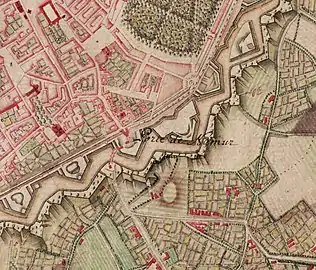 The Namur Gate on the 18th-century Ferraris map
The Namur Gate on the 18th-century Ferraris map One of the two former toll pavilion at the Namur Gate, now at the entrance of the Bois de la Cambre/Ter Kamerenbos
One of the two former toll pavilion at the Namur Gate, now at the entrance of the Bois de la Cambre/Ter Kamerenbos
The "Namur Gate" district
The name Namur Gate ended up designating the whole of the Ixelles neighbourdhood, which at the beginning of the 20th century, became one of the most popular places in Brussels' upper town, a meeting place for the wealthy class and artists. The district back then had many cafés, chic restaurants, luxury shops, performance halls, and later, cinemas.
The modernisation of the road infrastructure in the second half of the 20th century marked the end of this period by transforming the district into a place of transit for cars. The Rue du Bastion/Bolwerkstraat, which linked the boulevards to the Chaussée de Wavre/Steenweg op Waver, was removed and replaced by an office tower, the Bastion Tower, and several neoclassical buildings also disappeared. Performance halls were transformed into department stores or fast food outlets.
Nowadays, the Namur Gate area is once again becoming a busy commercial centre, less elitist than in the past, and one of the liveliest districts in the city. It merges in part with the so-called Matongé district, a meeting place for African communities in Brussels.
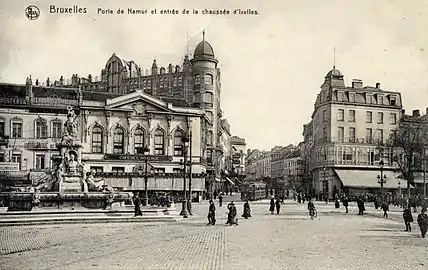 The Namur Gate and the Chaussée d'Ixelles/Elsensesteenweg, c. 1900
The Namur Gate and the Chaussée d'Ixelles/Elsensesteenweg, c. 1900.jpg.webp) The Namur Gate in the 1980s
The Namur Gate in the 1980s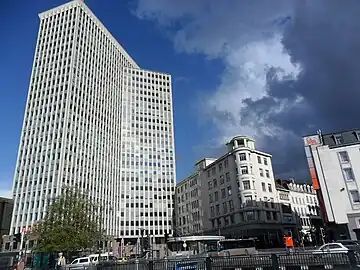 The Namur Gate as it appears today
The Namur Gate as it appears today
See also
- Halle Gate, a part of the 13th-century city wall protecting Brussels
- Black Tower, another part of the 13th-century city wall protecting Brussels
- Anneessens Tower, another part of the 13th-century city wall protecting Brussels
- Villers Tower, also named St. James Tower, another tower in the 13th-century city wall in Brussels
- History of Brussels
- Belgium in "the long nineteenth century"
References
Footnotes
- It was reinstalled in Laeken, on the Avenue Jean Palfyn/Jean Palfynlaan, opposite the King Baudouin Stadium, in 1977.
Notes
- Michel Hainaut & Philippe Bovy, À la découverte de l'histoire d'Ixelles : Porte de Namur. Ixelles, April 2000, 16 p.
